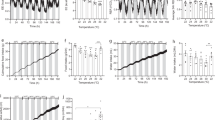Abstract
-
1.
The capacity for thermoregulation and thermogenesis in lean and genetically obese (ob/ob) mice has been investigated.
-
2.
At 4°C ob/ob mice rapidly die of hypothermia, because of a reduced capacity for cold-induced thermogenesis, but the animals are able to survive if previously adapted to 12°C.
-
3.
At all environmental temperatures between 30°C and 10°C the body temperature of ob/ob mice is 2.0–2.5°C below that of lean animals. This may be due to a lower “setting” for body temperature.
-
4.
At 34°C the oxygen consumption of obese mice is greater than that of the lean animals while at 30°C it is similar. When the environmental temperature is below 30°C the oxygen consumption of the lean mice is greater. The obese animals therefore expend less energy on thermoregulatory thermogenesis.
-
5.
The capacity for non-shivering thermogenesis was measured in lean and obese mice by investigating the effect of an injection ofl-nor-adrenaline (1000 μg/kg body weight) on the metabolic rate at 31°C. Non-shivering thermogenesis was reduced by one-half in the obese animals.
-
6.
One cause of the obesity of the ob/ob mouse is its high metabolic efficiency. We suggest that this high metabolic efficiency is due, at least in part, to less energy being expended on thermoregulatory thermogenesis.
Similar content being viewed by others
References
Abraham, R. R., Beloff-Chain, A.: Hormonal control of intermediary metabolism in obese hyperglycaemic mice. I. The sensitivity and response to insulin in adipose tissue and muscle in vitro. Diabetes20, 522–534 (1971)
Alonso, L. G., Maren, T. H.: Effect of food restriction on body composition of hereditary obese mice. Am. J. Physiol.183, 284–290 (1955)
Davis, T. R. A., Mayer, J.: Imperfect homeothermia in the hereditary obese-hyperglycemic syndrome of mice. Am. J. Physiol.177, 222–226 (1954)
Hollifield, G., Parson, W.: Body composition of mice with gold thioglucose and hereditary obesity after weight reduction. Metabolism7, 179–183 (1958)
James, W. P. T., Trayhurn, P.: An integrated view of the metabolic and genetic basis of obesity. Lancet1976II, 770–773
Jansky, L.: Non-shivering thermogenesis and its thermoregulatory significance. Biol. Rev.48, 85–132 (1973)
Joosten, H. F. P., van der Kroon, P. H. W.: Role of the thyroid in the development of the obese-hyperglycemic syndrome in mice (ob/ob). Metabolism23, 425–436 (1974)
Stock, M. J.: An automatic, closed-circuit oxygen consumption apparatus for small animals. J. Appl. Physiol.39, 849–850 (1975)
Trayhurn, P., Thurlby, P. L., James, W. P. T.: A defective response to cold in the obese (ob/ob) mouse and the obese Zucker (fa/fa) rat. Proc. Nutr. Soc.35, 133A (1976)
Trayhurn, P., Thurlby, P. L., James, W. P. T.: Thermogenic defect in pre-obese ob/ob mice. Nature266, 60–62 (1977)
Welton, R. F., Martin, R. J., Baumgardt, B. R.: Effects of feeding and exercise regimens on adipose tissue glycerokinase activity and body composition of lean and obese mice. J. Nutr.103, 1212–1219 (1973)
Author information
Authors and Affiliations
Rights and permissions
About this article
Cite this article
Trayhurn, P., James, W.P.T. Thermoregulation and non-shivering thermogenesis in the genetically obese (ob/ob) mouse. Pflugers Arch. 373, 189–193 (1978). https://doi.org/10.1007/BF00584859
Received:
Issue Date:
DOI: https://doi.org/10.1007/BF00584859




